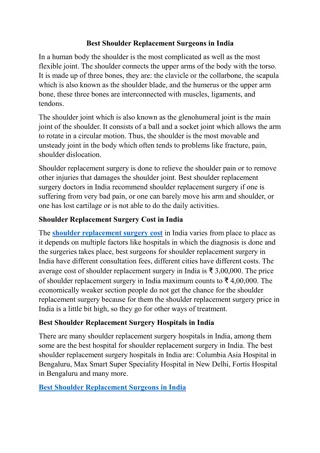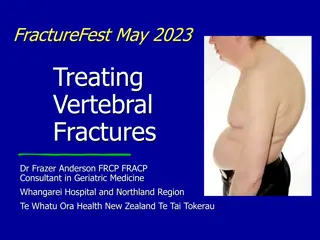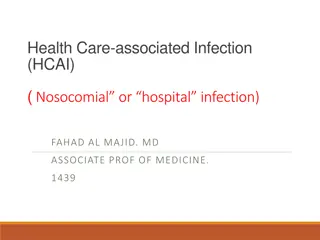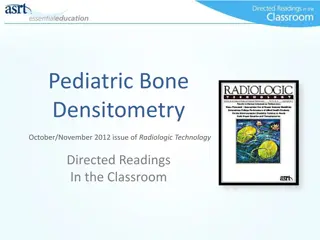Microbiology of Bone and Joint Infections: Comprehensive Overview
This lecture delves into the microbiology of bone and joint infections, covering important aspects such as definitions, pathogenesis, causative agents, diagnosis, and management of osteomyelitis and arthritis. It emphasizes the commonality of these infections in infants and children, highlighting risk factors, routes of infection, and specific pathogens associated with different clinical scenarios. Understanding these microbial aspects is crucial for effective diagnosis and treatment strategies.
Download Presentation

Please find below an Image/Link to download the presentation.
The content on the website is provided AS IS for your information and personal use only. It may not be sold, licensed, or shared on other websites without obtaining consent from the author. Download presentation by click this link. If you encounter any issues during the download, it is possible that the publisher has removed the file from their server.
E N D
Presentation Transcript
Lecture : Microbiology of Bone and Joint Infections important Extra notes Doctors notes " . "
Objectives: 1. Define osteomyelitis and arthritis 2. Know that the two conditions can happen together or separately. 3. Differentiate between acute and chronic osteomyelitis and arthritis 4. Know the pathogenesis and risk factors of both osteomyelitis and arthritis 5. Realize that bone and joint infections can be acquired through blood or directly from adjacent affected organs and tissues. 6. Know the commonest causative agents of arthritis and osteomyelitis. 7. Know the laboratory diagnosis and investigation of both conditions. 8. know the management and treatment of both osteomyelitis and arthritis.
Introduction Bone & joint infections may exist separately or together. Both are more common in infants and children Usually caused by 1- blood borne spread , but can result from 2- local trauma or spread from 3- contiguous soft tissue infection. Often associated with foreign body at the primary wound site. If not treated lead to devastating effect Note: Bacteremia is presence of bacteria in the blood.
What is Acute Osteomyelitis: Definition: Acute osteomyelitis is acute infectious process of the bone and bone marrow . Duration: 1) a short duration few days for hematogenously* (also called primary) acquired infection Most commonly in metaphysis 2) last several weeks to months if secondary to contiguous focus* of infection In association with peripheral vascular disease (chronic disease) diabetes mellitus ,severe atherosclerosis, vasculitis * * Relapse can occur if only osteomyelitis is treated without treating the surrounding tissue infection (focus)
How they reach Risk Group Primary Hematogenous route site:(Metaphysis of long bones ) Children and infants common Adult less common (may occur due to reactivation of a quiescent infection from infancy or childhood)** -most cases are due to S.AUREUS -S. Aureus septic arthritis (begins in the diaphysis) -Vertebral- GU infection -Candida Venous Catheter Infant : S.aureus, group B streptococci , gram ve rods like E.coli. ) ( focus of Children: S.aureus, group A streptococci, H.influenzae. Contiguous soft tissue focus Post operative infection, contaminated open fracture, soft tissue infection , puncture wounds Gram positive cocci, Gram negative bacilli, anaerobes, and poly- microbial infection. ) ( Special clinical situations Coagulas -negative staphylococci, and corynebacterium (normal flora of skin) Propionebacterium, and S.aureus in foreign body infections Prosthesis Enterobacteriacea and Pseudomonas Nosocomial infections ( hospital acquired infection ) and IV drug use Fist injuries, and diabetic foot and dicubitus ulcers, Streptococci ,, anaerobes in sickle cell patients a.Aureus , Salmonella or S. pneumoniae Human/ animal bites; Eikenella, Pasturella multocida AIDS. Mostly chronic M.tuberculosis or M. avium (Mycobacterium tuberculosis ( MTB) or Mycobacterium avium ) Infection after trauma ,injury or surgery S.aureus, group A Streptococcus,Gram negative rods, anaerobes. -RED: very important,Make sure you know it all.- The rest: give it a quick read and focus on the underlined. **
What is Acute Osteomyelitis: Patient presentation: Systemic manifestations occurs in less than 50% of patients. Acute osteomyelitis usually of abrupt onset Acute onset of bone pain, fever with rigors and diaphoresis . Symptoms usually of less than 3 week s duration. Local signs : soft tissue swelling, erythema, warmth, point tenderness, percussion tenderness over the vertebral body & limited mobility of the involved extremity. Differential diagnosis: Primary and metastatic bone malignancies Trauma Acute rheumatic arthritis Hemarthrosis Ewing sarcoma Vertebral compression fracture. Clinical presentation & blood tests: Acute osteomyelitis usually of abrupt onset fever localized pain , heat , swelling Tenderness of affected site (one or more bones or joints affected in hematogenous spread). May be local tissue infection (abscess or wound) . Blood test: leukocytosis, high ESR and C-reactive protein.
What is Acute Osteomyelitis: Diagnosis Laboratory CBC (Count Blood Cell): Leukocytosis may or may not occur Erythrocyte sedimentation rate (ESR) elevated, but could be normal as well (not specific). Radiological X-ray : normal early in disease, soft tissue swelling , subperiosteal elevation seen early and Bone destruction changes seen by 2-4 weeks Blood culture. Aspiration of overlying abscess Biopsy if blood cultures are negative, and it s most specific. MRI highly sensitive & specific, preferred for vertebral osteomyelitis and cases associated with contiguous foci of infection or peripheral vascular disease. CT Scan used as alternative of MRI. Technetium bone scan, Gallium and Indium-111 labelled WBC scan* (detection within 3 days of onset). Maximum effect to rule out osteomyelitis. *Indium-111 labelled WBC scan: Also called indium scan , it s a nuclear medicine procedure in which while blood cells (mostly neutrophils) are removed from the patient, tagged ( ) Indium-111, and then injected intravenously back into the patient. The tagged leukocytes subsequently localize to areas of relatively new infection. with the radioisotope
What is Acute Osteomyelitis: Organisms Antibiotics Duration/Surgery/complication and follow up Methicillin sensitive (MSSA) Ex: Staph.aureus Cloxacillin, cefazolin or Clindamycin . Early treatment is critical Treat for 2-4 weeks parenteral (I.V) followed by oral therapy for a total of at least 6 weeks. Methicillin resistant(MRSA) Ex: Staph.aureus Vancomycin followed by Clindamycin, Linezolid, or TMP-SMX (cannot use Beta-Lactam antibiotics) Surgery for neurological complications, para- vertebral abscess & hip joint involvement. Complications: septicemia, metastatic abscesses, septic arthritis, chronic osteomyelitis, loss of limb ,or paravertebral abscess. Monthly ESR for 3 months and at 6 months useful to document treatment. Cases due to contiguous source more difficult to eradicate, Relapse common (50%) , surgery indicated. Polymicrobial* infection: Ampicillin-Sulbactam, Piperacillin-Tazobactam or Quinolone with Metronidazole. S.epidermidis: Vancomycin and Rifampicin Enterobacteriacae: Ceftriaxone Other Gram negative bacilli: Quinolones P. aeruginosa: Cefepime, Meropenem, or Piperacillin +/- Aminoglycoside. Anaerobes: Metronidazole or Clindamycin *more than one organsm
Chronic Osteomyelitis: A chronic infection of the bone and bone marrow usually secondary to inadequately treated or relapse of acute osteomyelitis. Has to be managed carefully, sometimes it is very difficult to handle Very long chronic disease (May recur many years, decades, after initial episode.) Majority of them are coming from other site, majority of patients have vascular disease TB and Fungal are common causes Risk Factors: Host Risk Factors: 1. 2. 3. 4. Penetrating trauma Prosthetic devices Animal bites IV drug use 1. 2. 3. 4. 5. Peripheral vascular disease Peripheral neuropathy Sickle cell disease Diabetes mellitus Immunocompromised states. If the infection tacking long time to heal , Always remember TB epically in elderly and immune compromised patient
Chronic Osteomyelitis: Causative Agents: The most common pathogen Other microorganisms Decubitus ulcers and diabetic foot infections. S.aureus S.epidermidis,enterococci,streptococc i,Enterobactericae,Pseudomonas, Polymicrobial infection common Acinetobacter spp., anaerobes (Bacteroides, anaerobic streptococci, Clostridium)
Chronic Osteomyelitis: Clinical presentation and DD: Patient Presentation: Acute symptoms and systemic manifestations are uncommon. Sinus tract Persistent wound drainage Chronic non-healing ulcer Local signs may be absent except during acute exacerbation. Overlying skin may be scarred and adherent to the involved bone. Differential Diagnosis Osteoid osteoma Osteosarcoma Secondary bony metastases Paget s disease of the bone Gout
Chronic Osteomyelitis: In immunosuppressed immunosuppressed patients: 2. Fungi Hematogenous osteomyelitis due to fungi eg. Candida spp., Histoplasma capsulatum, Aspergillus spp Other fungi may occur. 1. Mycobacteria Tuberculosis (MTB) MTB osteomyelitis(may be seen in immunosuppressed patient) Primarily results from hemtogenous spread from lung foci Or, as an extension from a caseating lymph bone ( 50% in spine). It resembles Brucella oesteomyelitis . TB & Brucella are common in KSA.
Chronic Osteomyelitis: Diagnosis 2-Radiological 1-Laboratory WBC normal, ESR elevated but not specific. Blood culture not very helpful- because as bacteremia rare. Definite microbiological diagnosis by culture of bone biopsy or FNA & Histological examination Surgery for diagnosis and therapeutic purposes Wound /sinus culture not reliable. Isolation of MRSA or vancomycin resistant enterococci should initiate infection control measures. Radiologic changes complicated by the presence of bony abnormalities MRI helpful for diagnosis and evaluation of extent of disease. Combined bone scan and Indium WBC scan.
Chronic Osteomyelitis: Treatment and Management 1-Surgical 2-Medical Organisms Antibiotics Extensive surgical debridement with antibiotic therapy. Parenteral antibiotics for 3-6 weeks followed by long term oral suppressive therapy. Some patients may require life long antibiotic ,others for acute exacerbations. Other bacteria treat as acute osteomyelitis. MSSA: parenteral cloxacillin followed by oral treatment MRSA & S.epidermidis: Vancomycin ( with added Rifampicin ) then oral Clindamycin or TMP-SMX. TB 4 drugs : INH,RIF ,Pyrazinamide & Ethambutol for 2 ms followed by RIF + INH for additional 4 ms. Brucella with Tetracycline and Rifampicin for 2 to 3 months.
Chronic Osteomyelitis:Complications & Prognosis o Prognosis: o Complications: Recurrence Loss of limb Pathological fractures Primary epidermoid carcinoma of sinus tract Malignant histocytoma Secondary amyloidosis Lymphoma & multiple myeloma( rare) Relapses are frequent Doctor s nots: You should memorize: the method, drug, major clinical presentation and Two complication
http://t0.gstatic.com/images?q=tbn:lBKUYLZE38Fo9M:http://patientsites.com/media/img/388/hand_finger_joint_intro01.jpghttp://t0.gstatic.com/images?q=tbn:lBKUYLZE38Fo9M:http://patientsites.com/media/img/388/hand_finger_joint_intro01.jpg Septic Arthritis: Defenition : Septic (Infectious) Arthritis is inflammation of the joint space secondary to infection. Generally affects a single joint and result in suppurative inflammation. Hematogenous seeding of joint is most common. Symptoms: Pain, swelling, limitation of movement common symptoms Pathophysiology: Results from introduction of organisms into joint space as a results of bacteremia or fungemia from infection at other body sites. Occasionally results from direct trauma, procedures (arthroscopy) or from contiguous soft tissue infection. Risk factors: Age Diabetes Immunosuppresion- IV drug use - CV catheters - Prior joint damage (rheumatoid arthritis) or procedure (arthroscopy)-H/O sexually transmitted diseases.
Septic Arthritis:Etiology -Other Organisms : -Common Organisms: Streptococci and aerobic Gram negative bacilli. Lyme disease due to tick bite in endemic areas uncommon in ksa. Chronic arthritis may be due to MTB or fungi in Immunocopramized IV drug user Sternoclavecular or Sacroilliac due to P.aeruginosa S.aureus is most common cause. -Common causes of septic arthritis: Age/special conditions Common organism S.aureus, group B streptococcus, Gram negative rods. Neonates S.aureus, group A streptococcus, S.pneumoniae, H. influenzae type b Infants /children S.aureus, Neisseria gonorrheae Adults Salmonella species, S.aureus Sickle cell disease S.aureus Trauma /surgical procedure MTB, Fungi Chronic arthritis Skin flora Prosthetic arthritis
Septic Arthritis:Types: 1. Gonococcal arthritis: Gonococcal infection most common cause in young, sexually active adults Caused by Neisseria gonorrheae leads to disseminated infection secondary to urethritis in men /cervicitis in women. Early diseas: Initially present with polyarthralgia, tenosynovitis( especially of hands and wrist) , fever, skin lesions resulting from NON-suppurative arthritis. Late disease: If untreated leads to suppurative monoarthritis. 2. Non-gonococcal arthritis Nongonococcal arthritis occurs in older adults. Results from introduction of organisms into joint space as a results of bacteremia or fungaemia from infection at other body sites. Monoarthicular suppurative Arthritis Knee and wrist are the most common, fever and pain Swollen and tender join with Joint effusion and limitation of joint movement.
Septic Arthritis: Diagnosis: by arthocentesis to obtain synovial fluid for analysis Gram stain, culture & sensitivity History/examination to exclude systemic illness. Note H/O tick exposure in endemic areas and sexual contact. Samples Tests Differential Diagnosis: Arthrocentesis should be done as soon as possible; 1. 2. Synovial fluid is cloudy and purulent Leukocyte count generally > 50,000/mm3,with > 75 % PMN Gram stain and culture are positive in >90% of cases Exclude crystal deposition arthritis or noninfectious inflammatory arthritis. Crystal induced arthritis Gout, pseudogout Noninfectious inflammatory arthritis Acute rheumatoid arthritis Reactive arthritis Reiter syndrome, acute rheumatic fever Trauma Viral arthritis Parvovirus B19, Hepatitis B virus. 3. 4. Blood cultures - Culture of skin lesions can be performed and joint fluid indicated Cervix, urethra, rectum & pharynx Swab or urine If gonococcal infection : suspected for N.gonorrheae for culture and DNA testing for N.gonorrheae. Skin Rash Can be culture
Septic Arthritis: Treatment & Management Treatment: Drainage & antimicrobial therapy important management. Arthrocentesis with drainage of infected synovial fluid. Repeated therapeutic Arthrocentesis often needed Occasionally, arthroscopic or surgical drainage/debridement Antimicrobial therapy should be directed at the suspected organism and susceptibility results: Nongonococcal infectiuos arthritis: Gonococcal arthritis: IV Ceftriaxone ( or Ciprofloxacin or Ofloxacin) then switch to oral Quinolone or Cefixime for 7- 10 days. 1. 2. 3. 4. 5. 6. 7. MSSA: Cloxacillin or Cefazolin MRSA: Vancomycin Streptococci: Penicillin or Ceftriaxone or Cefazolin Enterobacetriacae: Ceftriaxone or Fluroquinolone Pesudomonas: Piperacillin and Aminoglycoside Animal bite : Ampicillin-Sulbactam Lyme disease arthritis: Doxycycline for 1 month. Change the antibiotics according to sensitivity, Arthrocentesis can repeated and Surgery rarely required
http://t1.gstatic.com/images?q=tbn:3SE14OFBbJRkFM:http://www.agrabilityproject.org/images/clip_image005_0003.jpghttp://t1.gstatic.com/images?q=tbn:3SE14OFBbJRkFM:http://www.agrabilityproject.org/images/clip_image005_0003.jpg http://t0.gstatic.com/images?q=tbn:eW4cuvhqCCKUnM:http://ajs.sagepub.com/content/35/7/1059/F1.large.jpg Septic Arthritis:Prognosis & Complications Prognosis: Gonococcal arthritis has an excellent outcome Risk factors for long term adverse sequellae include: Age Prior rheumatoid arthritis Poly-articular joint involvement Hip or shoulder involvement Virulent pathogens Delayed initiation or response to therapy Complications: Non-gonococcal arthritis: can result in scarring with limitation of movement, ambulation is affected in 50% of cases.
Infections of Joint Prosthesis: Occur in 1-5% of total joint replacement. Most infections occurs within 5 years of joint replacement. Often caused by skin flora Diagnostic aspiration of joint fluid necessary Result in significant morbidity and health care costs. Successful outcomes results from multidisciplinary approach. Risk factors: history of superficial wound infection, post surgical complications, underlying illness, any source of bacteremia. Differential diagnosis: Aseptic loosening or dislocation of prosthetic joint Prosthetic debris induced cynovitis & hemarthrosis
Infections of Joint Prosthesis: Etiology: Results from contamination during surgery or post op. wound infection adjacent to the prosthesis. Factors delay healing ( hematoma, ischemia) Occasionally result from bacteremia Prosthesis & bone cement predispose to infection Occurs at the prosthesis-bone interface Bacteria adhere to biomaterials and develop a biofilm that protect them from host defenses and antimicrobial agents. Mostly caused by coagulase negative staph., or S.aureus. Occasional pathogens: streptococci, enterococci ,and anaerobes Usually single pathogen ,occasionally polymicrobial Patient Presentation: Subacute onset S.aureus, streptococci,Gram negative rods can cause acute ,rapidly progressive infection Joint pain ,swelling most common Fever with acute ,early postsurgical infections Cellulitis, cutaneous wound, or discharging sinus overlying the joint.
Infections of Joint Prosthesis: Diagnosis of Prosthetic Arthritis: ESR and C-reactive protein( CRP ) may be high. Aspiration & surgical exploration to obtain specimen for culture & sensitivity testing & histopathology. Skin flora regarded as pathogens if isolated from multiple deep tissue cultures. Plain X-ray may not be helpful Arthrography may help define sinus tracts Bone scan-not specific for infection Treatment & Management: Surgical debridement and prolonged antimicrobial therapy -Surgery: removal of prosthesis -Antibiotic impregnated cement during re-implantation -Antimicrobial for 6 weeks: Begin empiric IV antibiotic to cover MRSA and Gram negative rods ( Vancomycin+ Cefepime, Ciprofloxacin,or Aminoglycoside) Chronic therapy with oral drug if removal of prosthesis not possible.
SAQ: 26 years old male with urethritis came with polyarthralgia, fever and skin rash. After taking his history, we found that he traveled to southern east Asia two weeks ago and he had sexual contact. And the blood culture indicates Gram Negative diplococci Bacteria. Q1: What is the most likely Diagnose in this case? It could be Gonococcal arthritis (septic Arthritis) Q2: What is the most likely organism can cause that? Neisseria gonorrhea bacteria. Q3: Blood culture is one of the samples that we can take it for diagnosis, list three samples we can take it also in this case? Arthrocentesis (Synovial fluid) / Culture of skin lesions / Cervix, urethra, rectum Swab / urine Q4: List three tests will help us in this case? Synovial fluid / DNA testing for N.gonorrheae / Gram stain / Leukocyte count. Q5: What is the prognosis in this case? Gonococcal arthritis has an excellent outcome especially with early stage of this disease. Q6: What is the treatment & management we recommend in this case? - IV Ceftriaxone (or Ciprofloxacin or Ofloxacin) - Then switch to oral Quinolone or Cefixime for 7-10 days. *zoom to see the answers ;) Did you study well ? https://www.onlineexambuilder.com/micro-3/exam-122235
SAQ: Q1: : List some Complications of Chronic Osteomyelitis? Recurrence / Loss of limb / Pathological fractures Secondary amyloidosis May develop cancer such as (Malignant histiocytoma / Lymphoma & multiple myelomas ) Q2: List two type osteomyelitis may have indolent chronic course? TB osteomyelitis / fungal osteomyelitis Q3: How can Mycobacteria Tuberculosis develop into chronic osteomyelitis? Either Primarily results from hematogenous spread from lung foci Or As an extension from a caseating lymph bone. Q4: List some Antibiotics we can use it to treat TB? Pyrazinamide & Ethambutol for 2 months followed by Rifampicin(RIF) + Isoniazid (INH) for additional 4 months. Q5: Infections of Joint Prosthesis Mostly caused by? coagulase positive staph (S.aureus) / coagulase negative staph (S.epidermidis). Q6: List Some organism can cause Acute osteomyelitis in infant? S.Aureus / group B streptococci / E.coli. Q7: List some Complications of Non-Gonococcal arthritis? scarring with limitation of movement. In 50% of cases, ambulation can occur.
GOOD LUCK! MICROBIOLOGY TEAM: Waleed Aljamal (leader) Shrooq Alsomali (leader) Ibrahim Fetyani Meshal Eiaidi Khalid Alhusainan Hussam Alkhathlan Faisal Alqumaizi Abdulaziz Alangari Khalid Alshehri Nasir Aldosarie Mohammad Al-Kahil Rawan Alqahtani Hanin Bashaikh Jawaher Alkhayyal Reem Alshathri Ohoud Abdullah Lama Al-musallam Wateen Alhamoud Ruba Barnawi Shooq Albugami The Editing File We are waiting for your feedback @microbio436 436microbiologyteam@gmail.com























